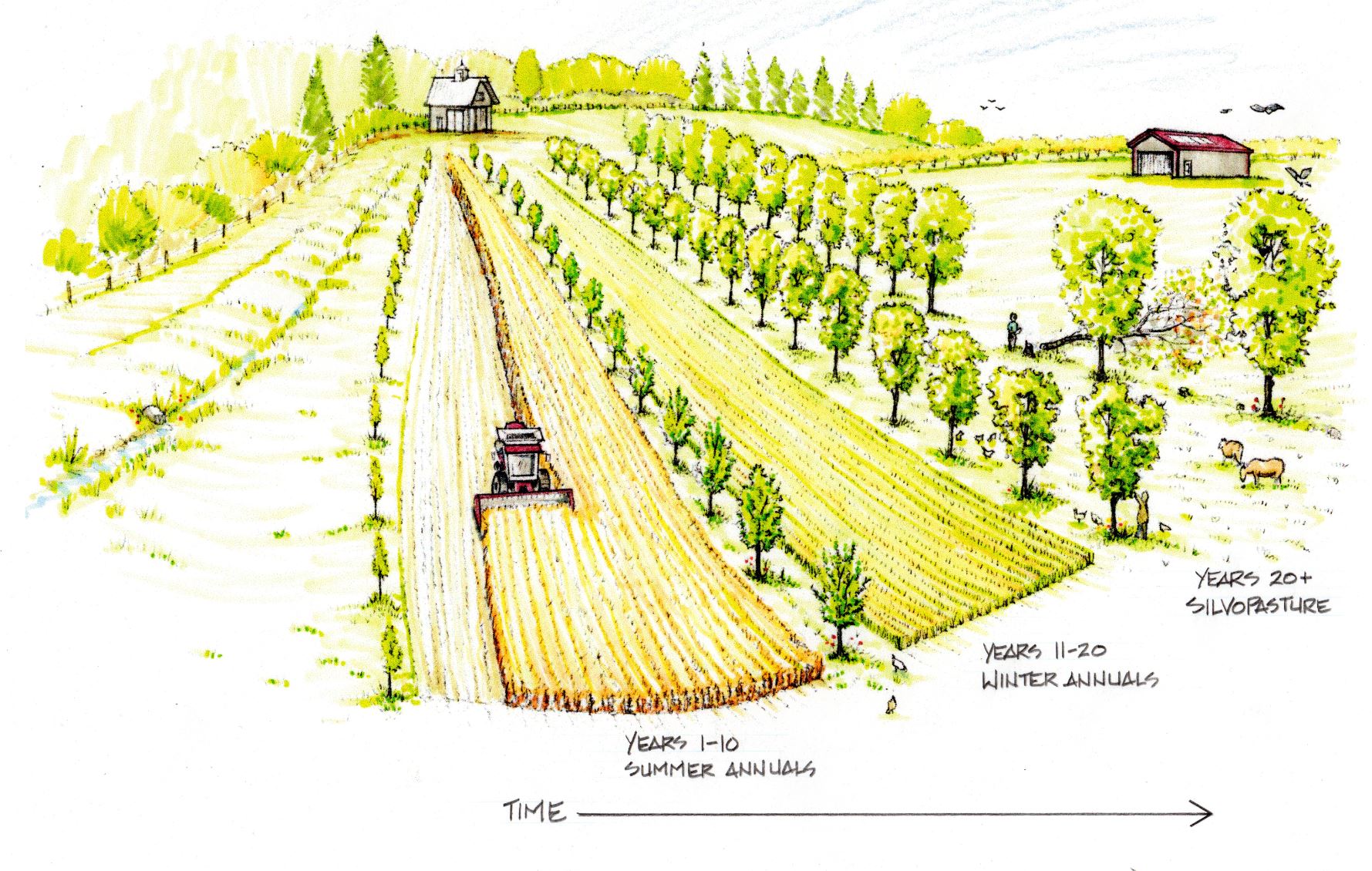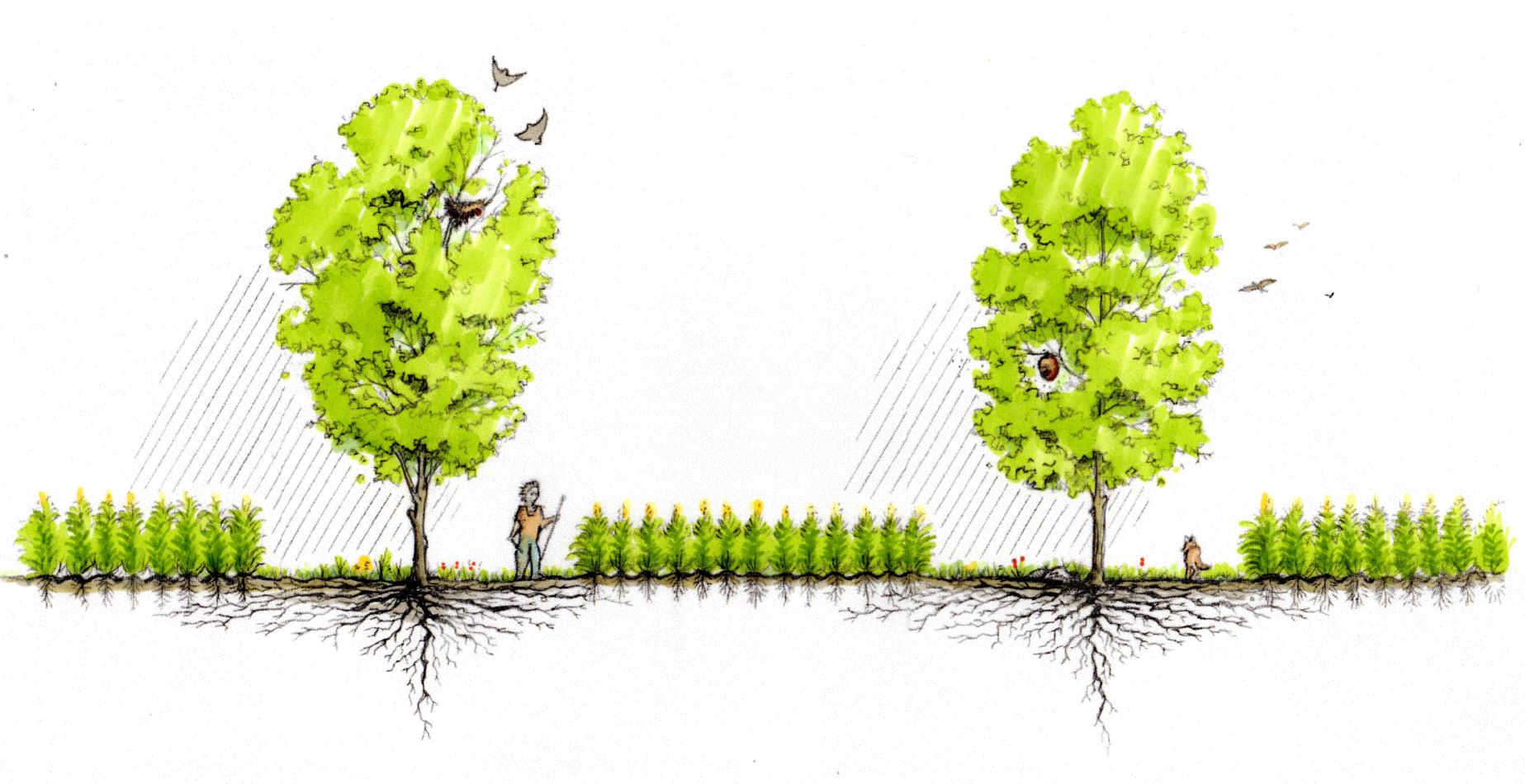Farmers who plant productive trees between row crops to diversify yields, reduce erosion, protect wildlife habitat, and store carbon have a new source of potential support, thanks to funding made available by The Nature Conservancy’s Natural Climate Solutions Accelerator Program and the Doris Duke Charitable Foundation. This February, $250,000 was awarded to the Savanna Institute, which will in turn provide support to participating farmers implementing alley cropping on their land (Figure 1). The Accelerator Program is funded through a generous grant from the Doris Duke Charitable Foundation.
 Figure 1: As this image of alley cropping demonstrates that alley cropping systems can be transitioned from summer annuals to winter annuals as trees mature, and finally to silvopasture or forest farming under a fully closed canopy.
Figure 1: As this image of alley cropping demonstrates that alley cropping systems can be transitioned from summer annuals to winter annuals as trees mature, and finally to silvopasture or forest farming under a fully closed canopy.
The Savanna Institute is working to help farmers and farmland managers accelerate alley cropping in Illinois, Iowa, Minnesota, and Wisconsin (Figure 2). In addition to increasing carbon storage by planting trees, alley cropping can increase land use efficiency by 40 to 200%, diversify farm income, improve soil retention, and provide wildlife habitat (Wolz et al. 20181, 20182). The Savanna Institute and its partners help tree farmers, crop farmers, landowners, and financial backers pull together their projects into an investment product to attract more support. The Savanna Institute will also provide monitoring services to evaluate environmental and agricultural performance.

“We are really looking forward to working with farmers across the Midwest to help put trees to work to enhance farm profitability, reduce erosion, improve wildlife habitat, and help store carbon,” said Keefe Keeley, Co-Executive Director of the Savanna Institute. “Our research shows at least 23% of all Midwestern farmland would be more profitable with rows of trees in it, compared to corn and soybean monocultures. If we gradually expand alley cropping to hit that target acreage over the next 30 years, farmers will take 1.07 gigatons of carbon dioxide out of the atmosphere. Even better, they’ll be putting that carbon to productive use in growing tree crops and building soil health. And farmers can do it while becoming more profitable through alley cropping.”
A 2018 study on the potential of natural climate solutions in the United States estimates that nature-based solutions could remove an additional 20 percent of U.S. greenhouse gas emissions, greater than the combined carbon emissions from all cars and trucks on the road in the United States (Fargione et al. 2018). Research completed by Savanna Institute collaborators have found that many temperate alley cropping systems “do not meet their full potential” due to the fact that they are often composed of only one timber tree species and only one annual grain species. Incorporating multiple woody crop species and selecting “tree crops” that produce food or fodder can dramatically increase the productivity and profitability of temperate alley cropping systems (Wolz et al. 20182) (Figure 3). Additional research has documented 410 tree species and 276 crop species used in alley cropping systems across 77 countries, but found that within-system was often low, with typically only one tree species and one crop species per system (Wolz et al. 20181). This accelerator program offers not only the potential to expand the practice of alley cropping, but to increase within-system tree diversity, promote multifunctional tree crops, and to explore the potential for perennial alley crops.
 Figure 3: A mature, diverse alley cropping system featuring a variety of tree crops and alley crops (Montpellier, France).
Figure 3: A mature, diverse alley cropping system featuring a variety of tree crops and alley crops (Montpellier, France).
The Savanna Institute was one of five projects nationally that won $850,000 worth of funding from The Nature Conservancy’s Natural Climate Solutions (NCS) Accelerator Grant Program, a competitive grant process. Winners were picked by a steering committee who targeted funding to innovative projects that will accelerate restoration of agricultural areas, forests, and coastal wetlands to improve carbon storage. Eriks Brolis, manager for the NCS Accelerator, noted that there has been strong and growing interest in this grant program. The Program received 70 proposals seeking a total of $5.8 million during the second request for proposals.
The Savanna Institute is a 501(c)(3) nonprofit organization working to lay the groundwork for widespread agroforestry in the Midwest (Figure 4). For more information visit: savannainstitute.org. Farmers, landowners, and investors interested in alley cropping can contact the Savanna Institute directly at 608-448-6432 or at This email address is being protected from spambots. You need JavaScript enabled to view it..
 Figure 4: Diverse alley cropping systems combine alley crops with tree crops while increasing habitat opportunities for wildlife and increasing income sources for farmers.
Figure 4: Diverse alley cropping systems combine alley crops with tree crops while increasing habitat opportunities for wildlife and increasing income sources for farmers.
References
Fargione JE, Bassett S, Boucher T, Bridgham SD, Conant RT (2018) Natural climate solutions for the United States. Science Advances 4: eaat1869. doi: 10.1126/sciadv.aat1869
1Wolz KJ and DeLucia EH (2018) Alley cropping: Global patterns of species composition and function. Agriculture, Ecosystems & Environment 252: 61–68. doi: 10.1016/j.agee.2017.10.005
2Wolz KJ, Lovell ST, Branham BE, et al. (2018) Frontiers in alley cropping: transformative solutions for temperate agriculture. Global Change Biology 24: 883–894. doi: 10.1111/gcb.13986

